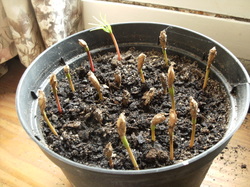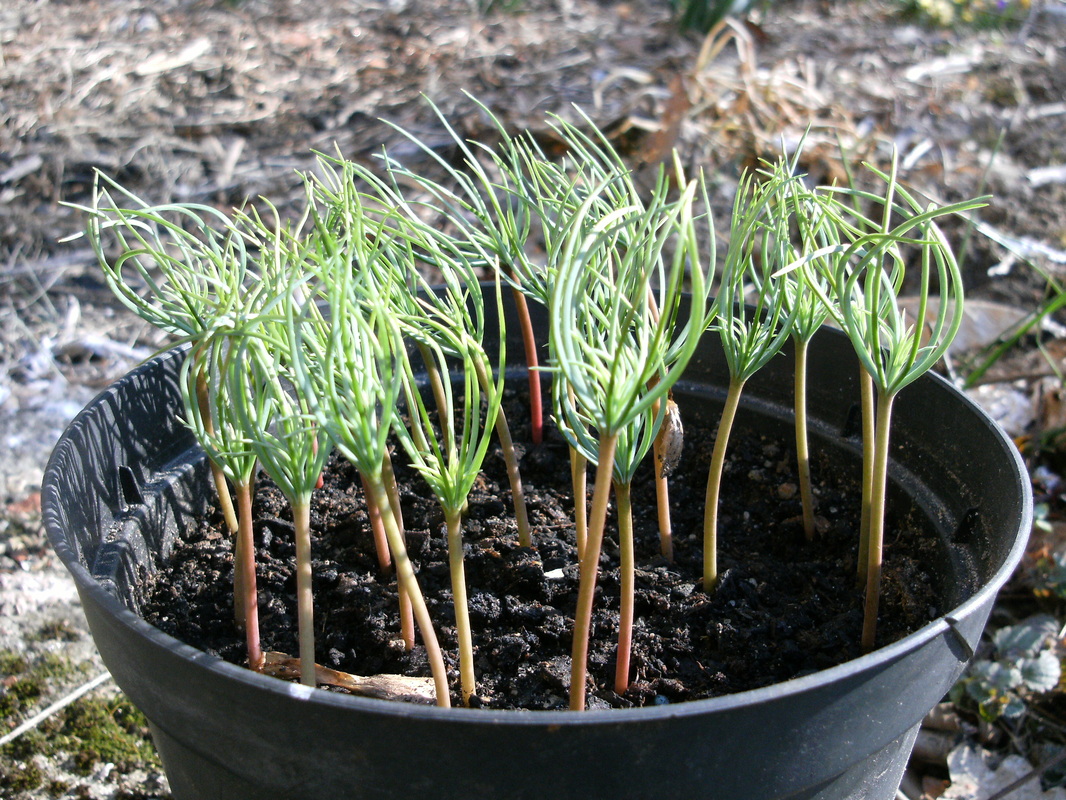 These are some of the seedlings that have grown from the germinating seeds that I extracted from mature Deodar cedar cones just a few weeks ago. It looks like every seed that was planted has come up. I'm keeping them slightly on the dry side to try to minimise the possibility of "damping off" which is caused by a fungal disease and once infected would cause the death of probably all seedlings in a few days. At the moment they look strong and vigourous. So fingers crossed
16 Comments
I spent a very cold couple of hours collecting cones from an isolated group of amazing Blue Atlantic Cedar trees. The trees are of immense stature and must be at least two centuries old.
Using a ladder to acces the lower branches I couldn't reach enough cones for my liking. I conected together the four sections of an ancient aluminium polesaw that now only has a hook attachment remaining. Using this I could reach around 10 meters (33ft) up into the trees. By hooking the cones and giving them a sharp tug I could snap off the cones, causing very little damage to the branches. After a couple of hours I had amassed several hundred cones, now the fun of extracting the seed begins. For most conifers you need to dry out the cones to allow the seed to fall out from between the cone scales. This does not however seem to work for cedrus atlantica glauca. After a little internet research I found a recommendation to soak the cones in water to soften then so that the scales will relax and begin to break apart. So far, after two days of soaking I have opened up a few cones to find very limited water penetration - more patience needed I guess. I have so far found that the only way to exract the seed has been to drill out the core of each cone and then remove each scale one at a time, picking out the plump seeds as I go. This method is not to difficult, but very time consuming for several hundred cones. So far I have managed to collect about 150 grams of seed using this method, but I need to get the seeds extracted as it will soon be time to start their pretreatment for Spring sowing. The seeds are lovely and fat and have not been subjected to any drying which quickly damages the viability, the parent trees are stunning and their offspring will make beutifull specimens - I am sure. Once the water has soaked into the cones it may be possible to freeze them to force the scales apart, at least that is what I have read. Thanks for reading, All the best - Michael I had the chance to collect a few more cones from a fairly young Deodar Cedar tree that is already begining to bear quite large numbers of cones. In contrast to the Blue Atlantic Cedar cones that I had collected the day before, these were already begining to break up. I had to take care to stop them falling apart before I could place them in my collecting bag.
It didn't take me long after my return home to start opening up the cones to extract the seed. Unfortunatly most of the seeds contained within the cones were empty. However within each cone were around 15-20 good seeds of around about 50% were already germinating within the cone. Some of the root radicles were at least 5mm long and required considerable care to extract them without breakage. This was a real surprise and I have sown the germinated seeds immediatly to give them the best chance of survival. The seeds have been able to germinate because the loosening of the cone scales prior to natural seed dispersal has allowed rainwater to get inside. This followed by our recent mild weather has allowed germination to occur. Thanks again, Michael |
About the authorI have always had a passion for trees and woodlands and spend my time looking at and thinking about little else. You can read much more about me on my "About Me" page listed at the foot of the pages list. Archives
June 2012
Categories
All
|

 RSS Feed
RSS Feed


